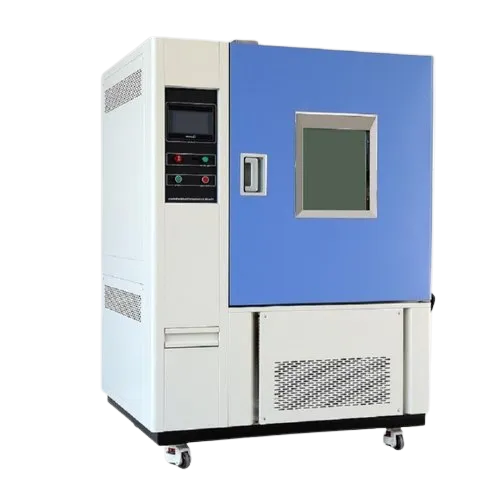Climatic Chamber Manufacturer

- The climatic chamber is a controlled-environment testing facility designed to simulate various climatic conditions. It allows precise control of temperature, humidity, and other environmental factors to assess the impact on materials, products, or components. These chambers are crucial for evaluating performance, reliability, and durability under diverse weather conditions.
- A climate chamber (-70ºC to 180ºC, Size: 120 to 1.000 Liters), also known as an environmental test chamber, is a sophisticated testing apparatus designed to simulate and control various climatic conditions to evaluate the performance and durability of materials, components, and products. These chambers replicate a wide range of environmental factors, including temperature, humidity, and sometimes light, allowing for comprehensive testing under diverse conditions.
- Climatic testing is used when one wants to test the behavior of a product in its normal context of use and to see, therefore, how it reacts to climatic change (what happens to electronic components if they are inadvertently stored in a warehouse with a high level of humidity) or which materials are most suitable for objects exposed to low temperature and humidity values.
Climate Test Chambers Industry Information
Climate chambers are also known as environmental chambers or climatic chambers. They are used to determine the effects of different environmental conditions on certain products or components, including industrial, biological, electronic, pharmaceutical, and other products.
- Quick links to Climate Chambers Information
- Applications of Climate Chambers
- Climate Chamber Design and Customization
- Factors to Consider When Purchasing Climate Chambers
- Applications of Climate Chambers
Climate Test Chamber Design and Customization
The sizes of climate chambers vary greatly, ranging from walk-in chambers to tiny cells. The majority of climate chambers come with video feeds installed so the operator may watch the product or component being tested. During the test, the tester can manually alter some settings thanks to reach-in chambers. Climate chambers are available with a wide range of control choices, including automatic and programmable control systems, basic analog indications, and contemporary digital readouts with LCD displays.
Factors to Consider When Purchasing Climate Test Chambers
There are a few things to think about while selecting a climate chamber. The chamber’s temperature range is the first. Standard chambers have a maximum temperature of 375°F, or 190°C, and a minimum temperature of -30°F, or -34°C. The best course of action for ranges that are higher or lower than usual is to get in touch with the manufacturers. The humidity range of the chamber is the second item to take into account. The product inside the chamber, the construction, the rate at which the temperature changes and the type of chiller system—water- or air-cooled—in the chamber are other factors to take into account. These will assist you in choosing the ideal chamber for your needs.
Specification | Description |
|---|---|
| Working Temperature Range | -70 to 150 oC |
| Temp. Deviation in time / in space (Approx.) | 1 oC |
| Rate of Cooling | 1 to 7 oC / Min. |
| Rate of Heating | User Specified |
| Humidity requirement | Humidity Range 20 to 98 % RH between 10 to 85 ºC |
| Dehumidification while Heating | Will be provided through separate in-built refrigeration system or dehumidification coil which help to avoid condensation on specimen. |
| Interior Walls | High grade Stainless steel- Grade AIS 304 or equivalent having embossed shelf support. |
| Port Holes | Two port holes- one in the left wall 50 mm and other in the right-side 125 mm wall of chamber with removable Silicon Plugs |
| Shelves | At least One stainless steel removable shelf with adjustable height/Load per shelf minimum 15 Kg/and total chamber loading be 100 Kg or more |
| Power Supplier | 3/N/PE AC 440 ± 10%- 50Hz or single phase 230 ± 10%- 50Hz-less than 12 KW |
| Sound pressure level | ≤75dB(A)-at one-meter distance. Vibration due to compressor is not desirable for test unit. |
